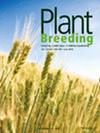瓜皮颜色基因 CmAPRR2 共显性标记的开发与应用
IF 1.8
4区 农林科学
Q2 AGRONOMY
引用次数: 0
摘要
瓜皮颜色是甜瓜外观的一个重要质量属性。鉴定目标基因和开发功能性分子标记对甜瓜果皮颜色育种意义重大。本研究对两个近交系的果皮颜色进行了遗传分析:H185(黑绿色瓜皮)和H160(白色瓜皮)以及果皮颜色基因CmAPRR2。目的是发现 CmAPRR2 基因的变异位点,并开发甜瓜果皮颜色的特异性分子标记。结果表明,黑绿色果皮对白色果皮为显性,单基因控制果皮颜色。在 H160 中,CmAPRR2 编码 DNA 区域的第八外显子发生了 G856T 碱基突变,表明该突变是导致白色瓜皮颜色的关键因素。因此,针对 CmAPRR2 基因开发了一个共显性分子标记 FC,并用于对 189 个 F2 个体进行分子鉴定。该标记揭示了基因型和表型之间的完全对应关系。此外,该标记还显示其他四个白皮有 G856T 突变。这项研究为有针对性地改良瓜皮颜色提供了依据,为瓜皮颜色的分子标记辅助育种提供了技术手段。本文章由计算机程序翻译,如有差异,请以英文原文为准。
Development and application of a codominant marker of the melon rind colour gene CmAPRR2
Rind colour is an important quality attribute of melon appearance. Identifying target genes and developing functional molecular markers is significant for rind colour breeding in melon. This study involved a genetic analysis of the fruit rind colours of two inbred lines: H185 (with black green melon rind) and H160 (with white rind) alongside a fruit rind colour gene, CmAPRR2 . The purpose was to discover the variation sites of the CmAPRR2 gene and develop specific molecular marker for rind colour in melon. The results showed that the black green rind is dominant over white, and single gene controls the colours. A mutation of the G856T base occurred in the eighth exon of the CmAPRR2 coding DNA region in H160, suggesting that this mutation is the key factor for the white rind colour. Thus, a codominant molecular marker, FC, for gene CmAPRR2 was developed and used for molecular identification of 189 F2 individuals. The marker revealed a complete correspondence between genotype and phenotype. Additionally, the marker revealed that the other four white rinds had G856T mutations. This study provides a basis for targeted improvement of melon rind colours, offering a technical means for molecular marker‐assisted breeding of melon rind colours.
求助全文
通过发布文献求助,成功后即可免费获取论文全文。
去求助
来源期刊

Plant Breeding
农林科学-农艺学
CiteScore
4.40
自引率
5.00%
发文量
74
审稿时长
3.0 months
期刊介绍:
PLANT BREEDING publishes full-length original manuscripts and review articles on all aspects of plant improvement, breeding methodologies, and genetics to include qualitative and quantitative inheritance and genomics of major crop species. PLANT BREEDING provides readers with cutting-edge information on use of molecular techniques and genomics as they relate to improving gain from selection. Since its subject matter embraces all aspects of crop improvement, its content is sought after by both industry and academia. Fields of interest: Genetics of cultivated plants as well as research in practical plant breeding.
 求助内容:
求助内容: 应助结果提醒方式:
应助结果提醒方式:


